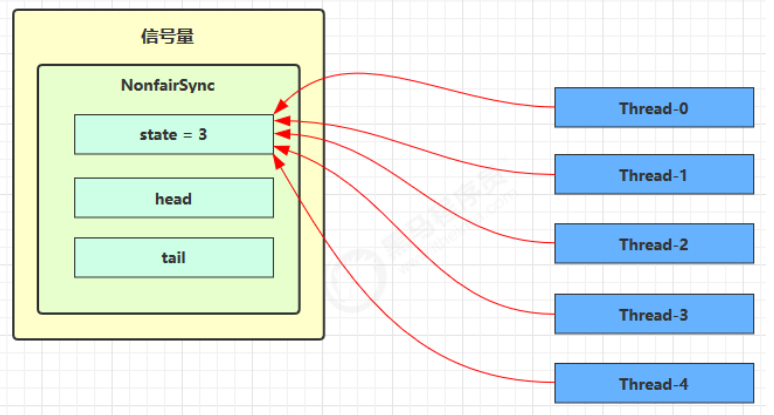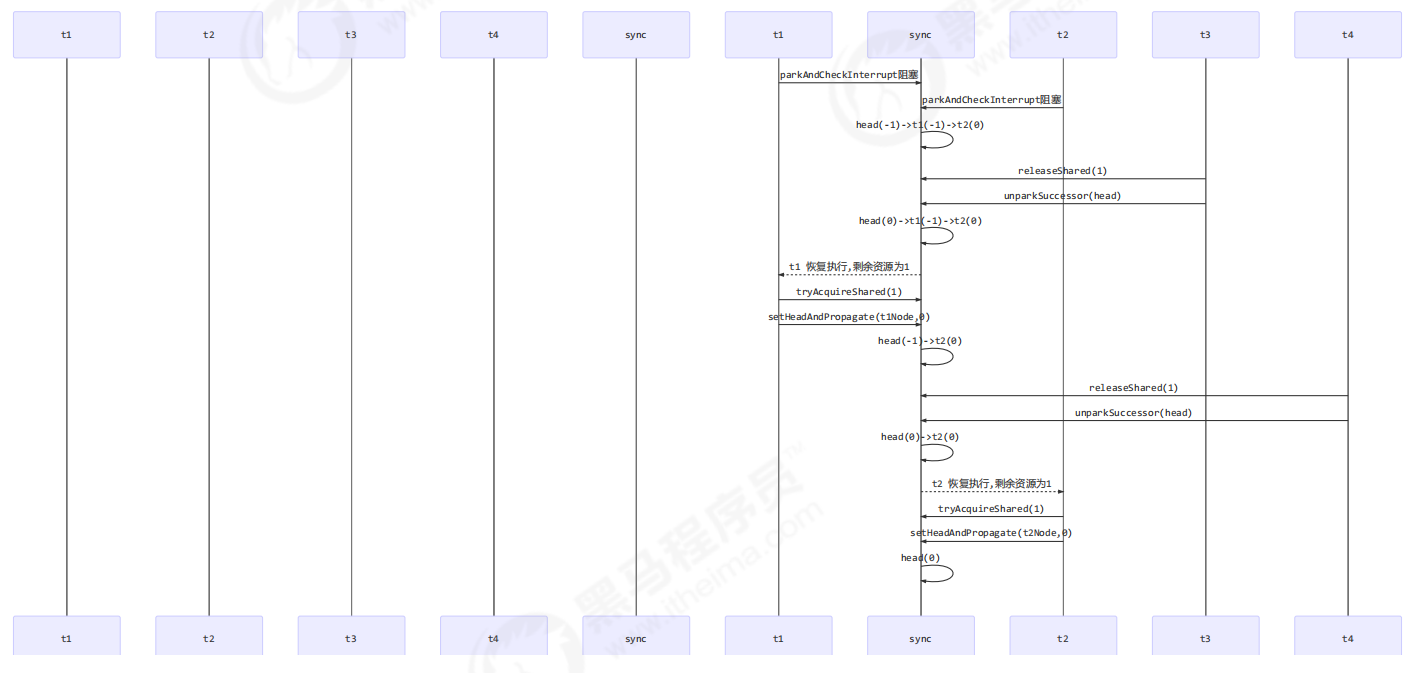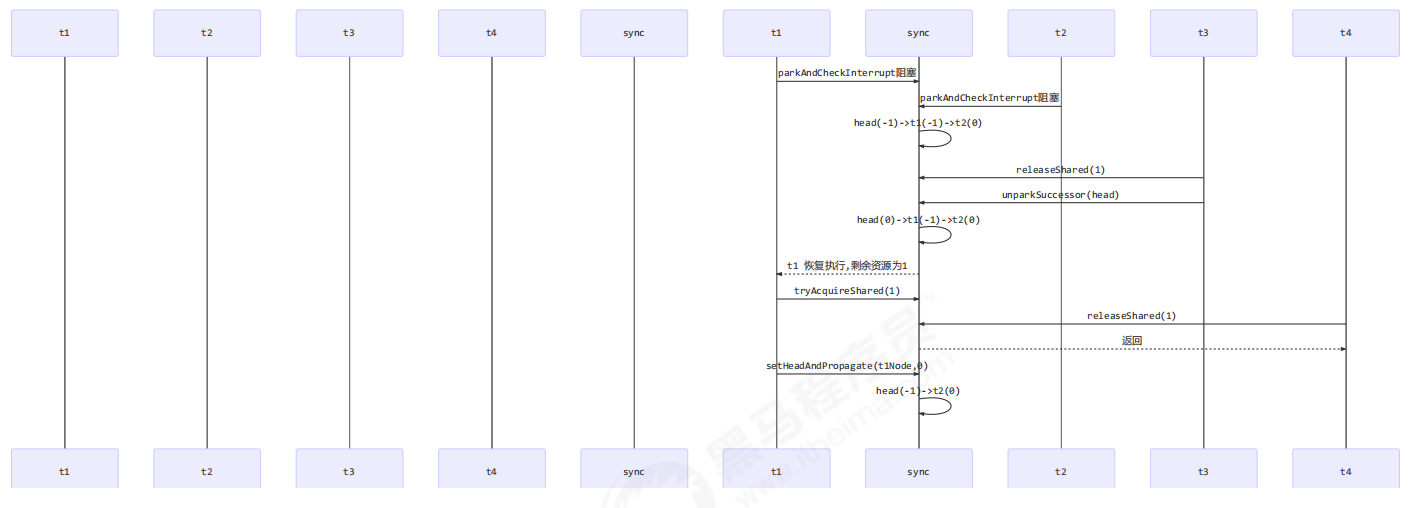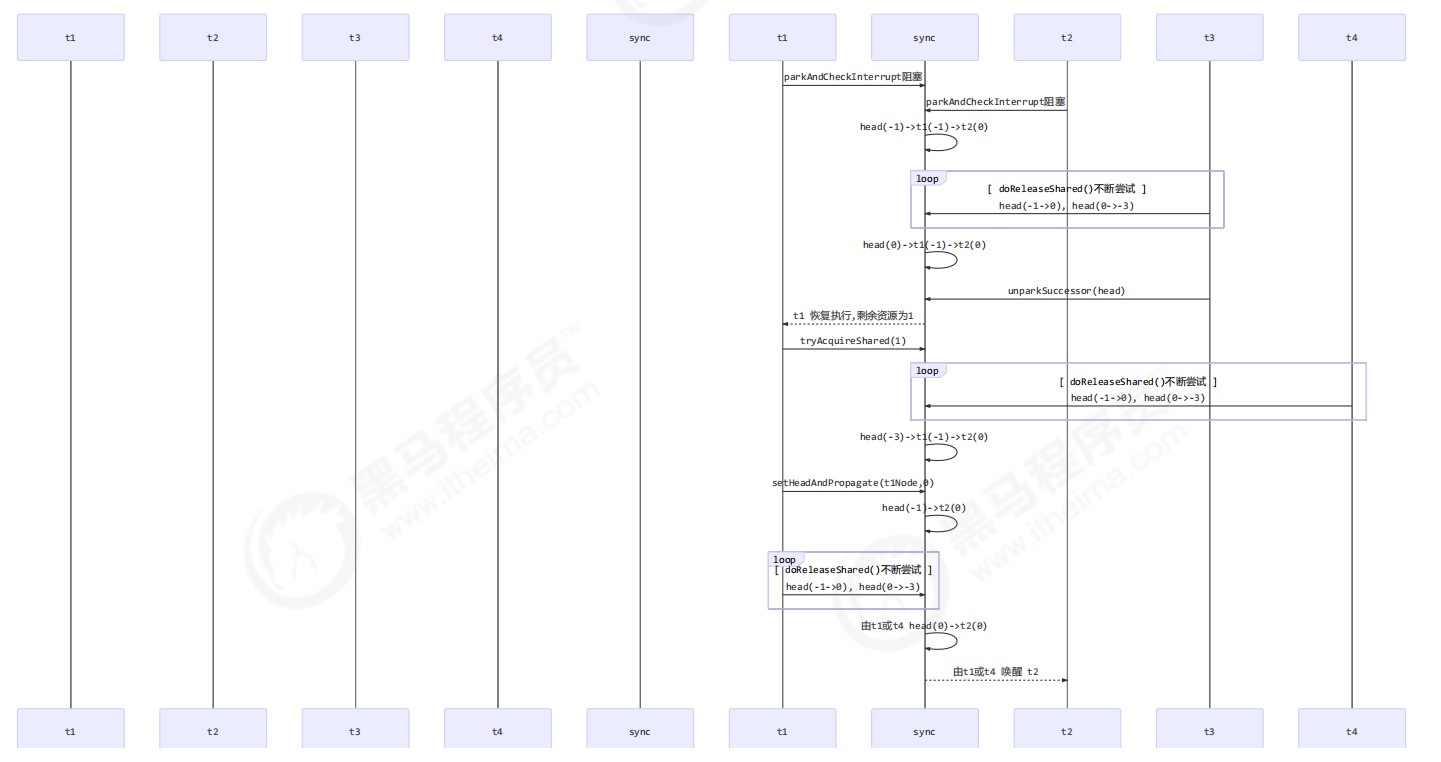Semaphore
基本使用
synchronized 可以起到锁的作用,但某个时间段内,只能有一个线程允许执行
Semaphore(信号量)用来限制能同时访问共享资源的线程上限,非重入锁
构造方法:
public Semaphore(int permits):permits 表示许可线程的数量(state)public Semaphore(int permits, boolean fair):fair 表示公平性,如果设为 true,下次执行的线程会是等待最久的线程
常用 API:
public void acquire():表示获取许可public void release():表示释放许可,acquire () 和 release () 方法之间的代码为同步代码
1
2
3
4
5
6
7
8
9
10
11
12
13
14
15
16
17
18
19
20
21
22
23
24
25
26
27
28
29
30
31
32
33
34
35
36
37
38
39
40
|
package hm.Semaphore;
import lombok.extern.slf4j.Slf4j;
import java.util.concurrent.Semaphore;
@Slf4j
public class SemaphoreTest {
public static void main(String[] args) {
Semaphore semaphore = new Semaphore(3);
for(int i =0;i<10;i++){
new Thread(()->{
try {
semaphore.acquire();
} catch (InterruptedException e) {
e.printStackTrace();
}
try {
log.debug("running...");
Thread.sleep(2000);
log.debug("end...");
} catch (InterruptedException e) {
e.printStackTrace();
} finally {
semaphore.release();
}
}).start();
}
}
}
|
Semaphore 应用 (实现简单连接池)
1. 加锁解锁流程
Semaphore 有点像一个停车场,permits 就好像停车位数量,当线程获得了 permits 就像是获得了停车位,然后 停车场显示空余车位减一 刚开始,permits(state)为 3,这时 5 个线程来获取资源

假设其中 Thread-1,Thread-2,Thread-4 cas 竞争成功,而 Thread-0 和 Thread-3 竞争失败,进入 AQS 队列
park 阻塞

这时 Thread-4 释放了 permits,状态如下

接下来 Thread-0 竞争成功,permits 再次设置为 0,设置自己为 head 节点,断开原来的 head 节点,unpark 接下来的 Thread-3 节点,但由于 permits 是 0,因此 Thread-3 在尝试不成功后再次进入 park 状态

2. 源码分析
1
2
3
4
5
6
7
8
9
10
11
12
13
14
15
16
17
18
19
20
21
22
23
24
25
26
27
28
29
30
31
32
33
34
35
36
37
38
39
40
41
42
43
44
45
46
47
48
49
50
51
52
53
54
55
56
57
58
59
60
61
62
63
64
65
66
67
68
69
70
71
72
73
74
75
76
77
78
79
80
81
82
83
84
85
86
87
88
89
90
91
92
93
94
95
96
97
98
99
100
|
static final class NonfairSync extends Sync {
private static final long serialVersionUID = -2694183684443567898L;
NonfairSync(int permits) {
super(permits);
}
public void acquire() throws InterruptedException {
sync.acquireSharedInterruptibly(1);
}
public final void acquireSharedInterruptibly(int arg)
throws InterruptedException {
if (Thread.interrupted())
throw new InterruptedException();
if (tryAcquireShared(arg) < 0)
doAcquireSharedInterruptibly(arg);
}
protected int tryAcquireShared(int acquires) {
return nonfairTryAcquireShared(acquires);
}
final int nonfairTryAcquireShared(int acquires) {
for (;;) {
int available = getState();
int remaining = available - acquires;
if (
remaining < 0 ||
compareAndSetState(available, remaining)
) {
return remaining;
}
}
}
private void doAcquireSharedInterruptibly(int arg) throws InterruptedException {
final Node node = addWaiter(Node.SHARED);
boolean failed = true;
try {
for (;;) {
final Node p = node.predecessor();
if (p == head) {
int r = tryAcquireShared(arg);
if (r >= 0) {
setHeadAndPropagate(node, r);
p.next = null;
failed = false;
return;
}
}
if (shouldParkAfterFailedAcquire(p, node) &&
parkAndCheckInterrupt())
throw new InterruptedException();
}
} finally {
if (failed)
cancelAcquire(node);
}
}
public void release() {
sync.releaseShared(1);
}
public final boolean releaseShared(int arg) {
if (tryReleaseShared(arg)) {
doReleaseShared();
return true;
}
return false;
}
protected final boolean tryReleaseShared(int releases) {
for (;;) {
int current = getState();
int next = current + releases;
if (next < current)
throw new Error("Maximum permit count exceeded");
if (compareAndSetState(current, next))
return true;
}
}
}
|
. 为什么要有 PROPAGATE
早期有 bug
1
2
3
4
5
6
7
8
9
|
public final boolean releaseShared(int arg) {
if (tryReleaseShared(arg)) {
Node h = head;
if (h != null && h.waitStatus != 0)
unparkSuccessor(h);
return true;
}
return false; }
|
1
2
3
4
5
6
7
8
9
10
11
12
13
14
15
16
17
18
19
20
21
22
23
24
25
26
27
28
29
|
private void doAcquireShared(int arg) {
final Node node = addWaiter(Node.SHARED);
boolean failed = true;
try {
boolean interrupted = false;
for (;;) {
final Node p = node.predecessor();
if (p == head) {
int r = tryAcquireShared(arg);
if (r >= 0) {
setHeadAndPropagate(node, r);
p.next = null;
if (interrupted)
selfInterrupt();
failed = false;
return;
}
}
if (shouldParkAfterFailedAcquire(p, node) &&
parkAndCheckInterrupt())
interrupted = true;
}
} finally {
if (failed)
cancelAcquire(node);
}
}
|
1
2
3
4
5
6
7
8
9
10
11
|
private void setHeadAndPropagate(Node node, int propagate) {
setHead(node);
if (propagate > 0 && node.waitStatus != 0) {
Node s = node.next;
if (s == null || s.isShared())
unparkSuccessor(node);
}
}
|
- 假设存在某次循环中队列里排队的结点情况为
head(-1)->t1(-1)->t2(-1)
- 假设存在将要信号量释放的 T3 和 T4,释放顺序为先 T3 后 T4
正常流程

产生 bug 的情况

修复前版本执行流程
- \1. T3 调用 releaseShared (1),直接调用了 unparkSuccessor (head),head 的等待状态从 -1 变为 0
- \2. T1 由于 T3 释放信号量被唤醒,调用 tryAcquireShared,假设返回值为 0(获取锁成功,但没有剩余资源 量)
- \3. T4 调用 releaseShared (1),此时 head.waitStatus 为 0(此时读到的 head 和 1 中为同一个 head),不满足条件,因此不调用 unparkSuccessor (head)
- \4. T1 获取信号量成功,调用 setHeadAndPropagate 时,因为不满足 propagate > 0(2 的返回值也就是 propagate(剩余资源量) == 0),从而不会唤醒后继结点, T2 线程得不到唤醒
bug 修复后
1
2
3
4
5
6
7
8
9
10
11
12
13
14
15
16
17
18
19
20
21
22
23
24
25
26
27
28
29
30
31
32
33
34
35
36
37
38
|
private void setHeadAndPropagate(Node node, int propagate) {
Node h = head;
setHead(node);
if (propagate > 0 || h == null || h.waitStatus < 0 ||
(h = head) == null || h.waitStatus < 0) {
Node s = node.next;
if (s == null || s.isShared()) {
doReleaseShared();
}
}
}
private void doReleaseShared() {
for (;;) {
Node h = head;
if (h != null && h != tail) {
int ws = h.waitStatus;
if (ws == Node.SIGNAL) {
if (!compareAndSetWaitStatus(h, Node.SIGNAL, 0))
continue;
unparkSuccessor(h);
}
else if (ws == 0 &&
!compareAndSetWaitStatus(h, 0, Node.PROPAGATE))
continue;
}
if (h == head)
break;
}
}
|

- T3 调用 releaseShared (),直接调用了 unparkSuccessor (head),head 的等待状态从 -1 变为 0
- T1 由于 T3 释放信号量被唤醒,调用 tryAcquireShared,假设返回值为 0(获取锁成功,但没有剩余资源量)
- T4 调用 releaseShared (),此时 head.waitStatus 为 0(此时读到的 head 和 1 中为同一个 head),调用 doReleaseShared () 将等待状态置为 PROPAGATE(-3)
- T1 获取信号量成功,调用 setHeadAndPropagate 时,读到 h.waitStatus < 0,从而调用 doReleaseShared (














